Computer outlet: types, categories, location rules and connection technology
A key condition for creating a communication system is to establish a structured work of the cable system, which cannot be implemented without computer outlets.
What types of connectors for communication automation are offered by the modern market and what features of installation does a computer outlet have, we will consider in the article.
The content of the article:
Computer outlet and its types
To connect computer equipment and any other peripheral equipment, a computer outlet of the RJ-45 standard is used. It complies with uniform communication norms and standards designed to automate most tasks.
The device includes a plastic case, inside of which from one to four connectors are placed.

To organize a home network, devices that are equipped with one or two connectors are most often used. In devices with two connectors, the first is for connecting to the data cable going to the computer, and the second is for switching with the punch panel.
Information Transmission Cable, referred to as "twisted pair", Just gets into the intended module with a contact. Through another twisted pair, the information goes to the network.

Externally, the computer RJ45 connector is similar to the telephone analogue of RJ11. But the main difference between the devices is the number of contacts. In telephone models, 4 contacts, and in information - 8 pieces. For this reason, if the computer RJ45 socket can be used as a telephone, then computer equipment can no longer be connected to the RJ11 socket.
The installation sequence for most types of computer sockets is typical. You need to perform a series of almost similar steps:
Outlet Categories
The distance to which the signal will be transmitted with minimal distortion, as well as the data rate itself, depends on what category the computer outlet belongs to.
When equipping office and household networks, these types of sockets are often used:
- RJ-45 Cat.5 - Designed to organize 100BASE-TX networks with a frequency band of 125 MHz with a data transfer rate of 100 Mbps.
- RJ-45 Cat.5e - a more "advanced" option that allows you to transfer data for two pairs within 100 Mbit / s., For four pairs - 1000 Mbit / s.
- RJ-45 Cat.6 - Designed for arranging Gigabit Ethernet and Fast Ethernet networks. The bandwidth of the device is up to 1000 Mbps.
There are several basic parameters by which computer sockets are divided. One of them is the installation method.
External and internal connection points
Depending on the installation method, the devices are divided into two types:
- External - used when the device must be placed on the surface of the wall. On the back side of the device for external installation there is a connector equipped with knife contacts. If a wire is pressed into them, the insulation breaks through the conductors, making installation much easier.
- Domestic - suggest installation inside the mounting box with the device buried in a cavity of a concrete, brick or drywall wall. The connector of such devices is usually removable. It is removed, and after installation in a wall socket deepened into the wall, it is clamped with a plastic screw.
Cases of devices for outdoor installation are made of durable technopolymers of a non-combustible type. Due to this, their outer surface is resistant to UV rays.
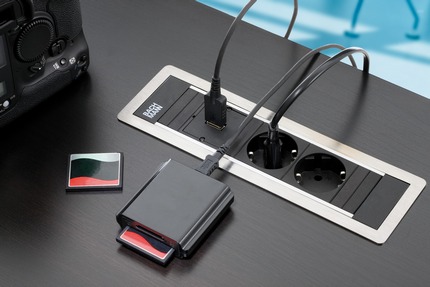
Complete and collapsible models
Depending on the type of configuration, the devices are divided into two types:
- With built-in modules. In the equipped models, the contact board and connectors are originally built in. They provide an invariable type of shielding.
- With interchangeable modules. In devices of this type, the modules are separated from the front panel. This solution allows you to make any combination: “UTP” and “FTP” of different categories - 3, 5, 6, 7.
Complete devices with integrated modules are affordable and easy to install.But in the event of a breakdown, the entire structure has to be replaced.

The main criterion that should be followed when choosing a device is the availability of additional ports. For example, if it is necessary to service several units of equipment, it is worth choosing double sockets of the RJ-45 type. In the two-module model, a computer can be connected to one RJ-45 port, and a telephone can be connected to the second RJ-11.
There are also models in which both modules are designed to connect computer equipment. But ports differ in category and type of shielding. The use of such devices allows you to save costs by combining modules for your needs and equipment category.
Give preference to products from trusted manufacturers. This is a guarantee that the products are manufactured in accordance with generally accepted norms and standards. High-quality devices will easily be combined with any type of computer equipment and calmly withstand the voltage of Russian networks.
Hardware Requirements
It is impossible to complete without a set of components connecting a computer outlet.
Separately, you will have to purchase:
- Cable (lan) corresponding category.
- Connector (jack) - A device in the form of an eight-pin plug for connecting a cable to a computer port.
- Patch panel - Provides the ability to quickly switch between active network equipment and operating points. The number of ports of the device depends on the number of connected equipment and can vary from 10 to 50.
To connect the RJ45 cat.5e socket, a four-pair shielded “twisted pair” cable is required, equipped with a common foil-type screen KVPE-5e 4x2x0.52. If you connect the RJ45 cat.6 model, you will also need a four-pair twisted-pair cable, but already of the KVP-6 4x2x0.57 type.

The eight-core cable for the Internet includes four twisted pairs. The second wire in each twisted pair has white insulation and is marked with a white stripe.
Information cables are divided into several categories, starting with the third. The higher the category, the higher the transmission standard.
To transfer data at 1 Gb / s, two-pair cables are used, and within 10 Gb / s - four-pair analogues. The difference between them in price is not big. And therefore, planning to use a larger number of conductors in the future, it is better to immediately purchase a four-pair network.
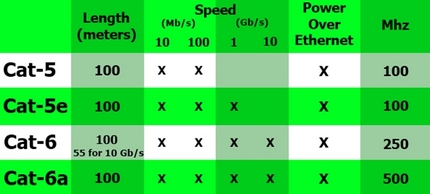
When installing connection points, preference should be given to shielded types of cables that are most protected from interference. Shielded cables are suitable for a wide range of tasks: telephony, smart TV, Ethernet.
If during the installation of the equipment the cable is not long enough or one of its sections is damaged, you can use the adapter “socket-socket”. When connecting a connector for cable extension, to avoid errors, you just need to focus on the color indicators printed inside the box.
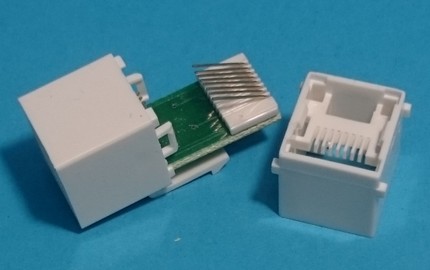
When choosing a pat panel, be guided by the category of the outlet. On sale there are devices of the category "5", "5e" and "6".
The end of the data cable is equipped with an 8P8C connector, referred to in the professional jargon as “jack”. It has a transparent case through which multi-colored wires are visible.
This item is often mistakenly called RJ45.But in fact, RJ45 is an accepted standard, and the exact name of the connector is 8P8C. Today, the standard for connecting twisted pair wires TIA / EIA-568-B, generally accepted since 2001, is used for connecting to equipment.
When connecting an Internet cable, two schemes are allowed: T568A and T568V. But in our country, wires are located mainly using the “B” scheme.
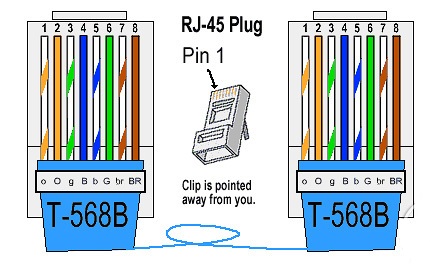
When connecting 10BASE-T and 100BASE-T networks, they use the TIA / EIA-568-A standard. Fear that when connecting a twisted pair, you can accidentally mix something up, do not. Modern router models are designed for both options. Therefore, they are able to automatically flip the signal.
Rules for the location of connection points
If you are not a fan of “garlands” of bound wires, you should seriously approach the issue of placing outlets. After all, every manipulation of installing and moving connection points implies at least redecorating the room.
Connecting a desktop computer requires at least five outlets. Therefore, the best solution would be to install a unit that includes several points: for a modem, monitor, system unit ...

In fairness, it is worth noting that it is also allowed to connect computer equipment without using outlets. But this installation method is too complicated to perform. And besides, it is completely unjustified, especially in those situations when you have to work with large networks.
Moreover, no one can guarantee with certainty that in the near future one more smart TV, computer or any other device will not be “powered” from this connection point.
If you need to increase the twisted pair, a detailed instruction on connecting the segments of the Internet cable set out here.
Technology for installing computer outlets
There is nothing complicated in connecting a computer outlet with your own hands. You just need to adhere to a given sequence in your actions.
Selection of the necessary tools
To carry out the work, it is necessary to prepare:
- hammer drill equipped with a crown of the corresponding diameter;
- crossing knife for stripping;
- Screwdriver Set;
- tester.
In addition to the main set of tools, it is worth taking care of acquiring crimping pliers in advance. This tool costs about $ 10. And therefore, for a one-time job, it makes sense to rent it.
Cable management and installation of the socket
The first step is to bring the cable to the installation point. It can be laid open or closed. The first method involves laying the cable in plastic boxes equipped with removable covers, or placing it behind the walls of the baseboard.
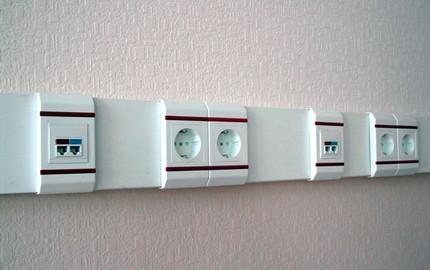
The so-called modular waybill method, which involves fixing the cable to the wall with the help of special dowels of the “quick installation” option, was also widely used.
To implement the second method, gates are made, into the cavity of which the cable is laid. To do this, using a puncher equipped with a special crown, make a round niche in the wall. The diameter of the crown must match the size of the box.
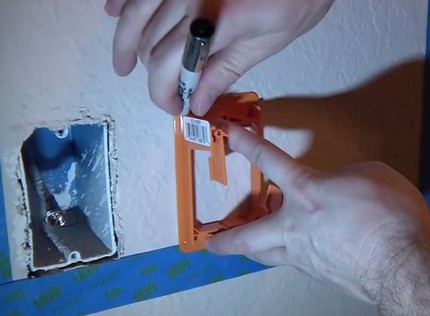
The end of the failed cable is cut off, leaving a margin for the possibility of subsequent multiple connections.The extra end must be carefully laid in a circle inside the box, avoiding fractures of the conductor.
Connect device contacts
To connect the power outlet, the outer protective insulation is removed using the blades of the cross-cutting knife, freeing the end 5-6 cm long. This procedure should be carried out carefully so as to avoid damage to the insulation of the conductors.
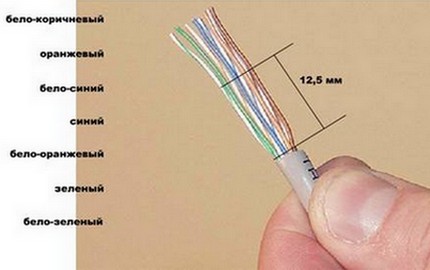
Each pair is neatly leveled. There is no need to clean them, since the platform device itself provides reliable contact. The front panel is removed from the body of the outlet by unscrewing the screw fixing it.
Some models of sockets are equipped with special latches that work like clamps. In such models, in order to remove part of the accessories and gain access to the internal mechanism, you need to carefully rotate the latch-handle located on the rear face.
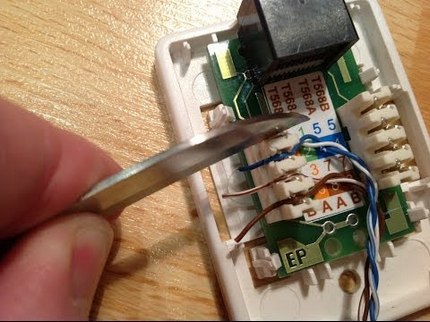
All cores are alternately in accordance with the color inserted into the latch. The end of each core is fixed with a clamping bolt. To drown each core as deep as possible, use the back of the clerical knife.
Color coding of the marking of all terminals greatly simplifies the process of docking a computer outlet and twisted pair crimping. Do not worry if the vein does not go all the way. When the latch returns to its original position, the recesses placed on the sides will push the cores to the end.
When all the conductors are led into the seats, the sticking pieces are carefully cut.
All about how the pinout of twisted pair conductors is made, you can read here.
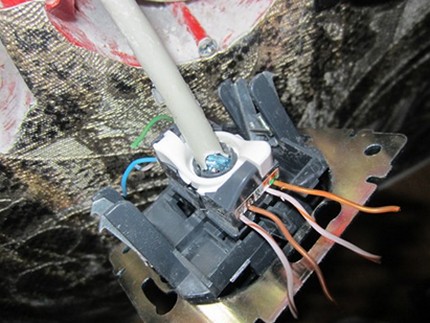
Using an open installation method, the device case is fixed on the wall, directing the computer connector down and the cable inlet up. With the closed installation method, the socket is buried in the socket prepared for it, fixing by means of spacers.
At the final stage, with the help of a tester, they verify that the connection is correct. If there is no tester at hand, it’s possible in a connected, but not yet installed into the rosette "Core" just stick the end of the cable going to the computer.
After making sure the connection is correct, all that remains is to screw on the front panel.
Connector Termination in Connector
To connect the connector, remove the insulation from the end of the cable. Each pair is untwisted and leveled, directing in different directions. If a shielding thin wire is provided, it is also bent to the side for a while.
When laying out pairs in a certain sequence they are guided by the “B” scheme described above.

Twisted pairs with cut ends of the wires lead into the cavity of the connector. The connector should be latched down. Each conductor is laid on a separate track, trying to push it all the way.
Connector with wires laid in it inserted into ticks. To close the connector, you need to smoothly bring the handle of the tick together.
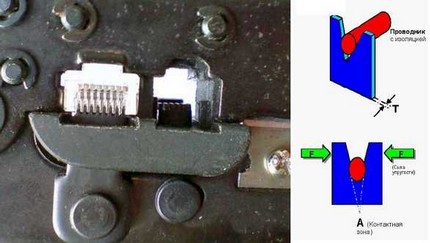
Ideally, if the connector body "fits" into the socket normally, no effort is required. If it is necessary to re-cable, you only need to cut the end again and perform the same actions, but with a different “jack”.
The technology for installing a double outlet is similar.The only thing is that you will have to put two cables from the router, since they do not use a parallel connection for network equipment.
Conclusions and useful video on the topic
Clip # 1. An example of installing a Viko RJ45 socket:
Clip # 2. How to crimp wires correctly:
Knowing how to connect an Internet outlet, you can always upgrade your home network on your own. The main thing is to adhere to the scheme and not get confused in the color designation of the wires.
Do you want to share your personal experience in the device sockets for connecting a computer or ask a question about interesting points? Found flaws in the article? Please write comments in the block below.

 Power socket for electric stove: types, device, technical standards and rules for connection
Power socket for electric stove: types, device, technical standards and rules for connection  How to connect a telephone socket: connection diagram and installation rules
How to connect a telephone socket: connection diagram and installation rules  Smart socket with remote control: types, device, how to choose a good one
Smart socket with remote control: types, device, how to choose a good one  How to connect an outlet block: installation rules and connection diagrams
How to connect an outlet block: installation rules and connection diagrams 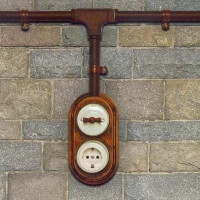 Overhead sockets and switches: rules for safe installation and connection
Overhead sockets and switches: rules for safe installation and connection 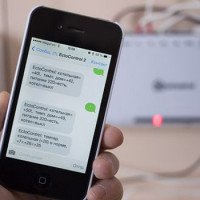 SMS socket: how a GSM-controlled socket works and is installed
SMS socket: how a GSM-controlled socket works and is installed  How much does it cost to connect gas to a private house: the price of organizing gas supply
How much does it cost to connect gas to a private house: the price of organizing gas supply  The best washing machines with dryer: model rating and customer tips
The best washing machines with dryer: model rating and customer tips  What is the color temperature of light and the nuances of choosing the temperature of the lamps to suit your needs
What is the color temperature of light and the nuances of choosing the temperature of the lamps to suit your needs  Replacement of a geyser in an apartment: replacement paperwork + basic norms and requirements
Replacement of a geyser in an apartment: replacement paperwork + basic norms and requirements
Recently, such sockets are increasingly used. They are really practical and look pretty stylish. The sockets built into the table are very convenient, there is no need to reach anywhere, there are no heaps of tangled wires.
As for the written material, I liked it, found a lot of useful things. Everything is explained correctly. It will help those who independently connect. I would also like to note the information content of the attached videos.
Computer sockets, like TV sockets, have been installed for a very long time and everywhere. Especially internal, because all the wires in the wall are not exposed to external influences, and the reliability is 100%! It’s convenient when everything is close at hand. I also stood, but finally had a fiber, I had to do a mini-repair. After all, this option requires accurate docking, the connection is different, such sockets were also on sale).
“Externally, the RJ45 computer jack is similar to the RJ11 telephone analogue. But the main difference between the devices is the number of contacts. In telephone models, 4 contacts, and in information - 8 pieces. For this reason, if the computer RJ45 socket can be used as a telephone, then computer equipment cannot be connected to the RJ11 socket. ”
Well, why ... For lack of computer sockets (RJ45) at speeds of up to 100 Mbps you can use telephone (RJ11). Accordingly, the network cable from the outlet to the computer is crimped by RJ11, from the computer side, RJ-45 is crimped. Internet providers, the same Rostelecom, use mainly two-pair network cables.